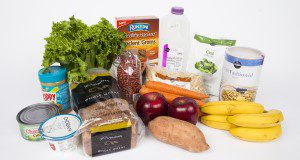Inflammation is your body’s response to injury and infection—it’s how your immune system helps to protect you from harm. In contrast, chronic inflammation contributes to many diseases, including heart disease, diabetes, and kidney and liver disease. This new 4-page publication of the UF/IFAS Food Science and Human Nutrition Department discusses inflammation and the dietary choices that may help to reduce chronic inflammation. Written by Daniela Rivero-Mendoza and Wendy Dahl.
https://edis.ifas.ufl.edu/fs402
Tag: Chronic Diseases
Dietary Fiber and Chronic Disease
Dietary fiber supports health in various ways. This 2-page document describes the relationships between dietary fiber and prevention and treatment of chronic disease. Written by Wendy J. Dahl and published by the UF/IFAS Department of Food Science and Human Nutrition, August 2018.
http://edis.ifas.ufl.edu/fs314
Enfermedad Renal Cronica (ERC): Una guia de alimentos can alto contenido de fibra

Vivir con la enfermedad renal crónica (ERC) presenta muchos desafíos, y la dieta es uno de ellos. Las personas con ERC pueden tener dificultades para consumir suficientes alimentos ricos en fibra al seguir las otras recomendaciones de dieta para la ERC..
This is the Spanish-language version of FS305, CKD: A Guide to Higher Fiber Foods. Written by Wendy J. Dahl and published by the UF/IFAS Department of Food Science and Human Nutrition, April 2018.
http://edis.ifas.ufl.edu/fs309
CKD: A Guide to Higher Fiber Foods
Living with chronic kidney disease (CKD) presents many challenges, and diet is one of them. People with CKD may find it difficult to consume enough fiber-rich foods while following the other diet recommendations for CKD. This 5-page guide will discuss the health benefits of fiber and provide some examples of fiber-rich foods that may be good choices for people with CKD. Written by Wendy J. Dahl and Nancy J. Gal and published by the UF/IFAS Department of Food Science and Human Nutrition, January 2018.
http://edis.ifas.ufl.edu/fs305
Living Well to Keep Your Pressure Down
High blood pressure, or hypertension, can cause serious health problems. It makes your heart work harder and can damage your blood vessels even if you feel okay. Everyone should have their blood pressure checked regularly. If you have certain risk factors, you are more likely to have high blood pressure. This 6-page fact sheet is a major revision that discusses risk factors and ways to reduce risk. Written by Linda B. Bobroff, and published by the UF/IFAS Department of Family, Youth and Community Sciences, revised November 2017.
http://edis.ifas.ufl.edu/fy305
Prevent Osteoporosis: Catch the Silent Thief
Osteoporosis means porous bones, or bones that have so many openings (pores) that they can easily break or be crushed. In the United States, 54 million people either have osteoporosis (10 million) or are at high risk (44 million) because they have low bone mass. By 2020, one in two Americans over the age of 50 is expected to have osteoporosis of the hip or be at high risk of developing the condition. This 11-page fact sheet discusses risk factors, calcium for bone building, calcium-rich foods, calcium supplements, vitamin D, and exercise. Written by Linda B. Bobroff, and published by the UF Department of Family, Youth and Community Sciences, revised February 2017.
http://edis.ifas.ufl.edu/fy469
Chronic Kidney Disease: Potassium and Your Diet
Potassium is an essential mineral required for normal body function. It helps maintain normal blood pressure, fluid and electrolyte balance, muscle and nerve function, as well as bone density. This three-page fact sheet describes potassium and its normal dietary importance, as well as the impact potassium levels have on those with Chronic Kidney Disease. Written by Ashley R. Kendall, Nancy J. Gal, and Wendy J. Dahl and published by the Food Science and Human Nutrition Department.
http://edis.ifas.ufl.edu/fs287
Chronic Kidney Disease: Phosphorus and Your Diet

Phosphorous is an essential mineral necessary for the formation of bones and teeth, but also for kidney function and the regulation of muscle contractions, heartbeat, and nerve transmission. High blood levels of phosphorus may lead to adverse effects on bone, kidney, and heart health. When there is too much phosphorus in the blood, the body reacts by leaching calcium from the bones. This can be especially dangerous for those with Chronic Kidney Disease. This four-page fact sheet discusses the relationship between Chronic Kidney Disease and Phosphorous intake, examining foods that are high in phosphorous and ways to manage phosphorous levels. Written by Nancy J. Gal, Lauren Headrick, Kate Bennett, and Wendy J. Dahl, and published by the Food Science and Human Nutrition Department.
http://edis.ifas.ufl.edu/fs273
Prevent Osteoporosis: Catch the Silent Thief (FCS8145/fy469)
 About 50 percent of women and 25 percent of men over age 50 will have a bone fracture caused by osteoporosis in their lifetimes. Many of these fractures, especially in the spine and hip, cause pain, disability, and loss of independence. About 24 percent of people aged 50 and over who have a hip fracture die in the year following the fracture. Learn more in this 8-page fact sheet written by Linda B. Bobroff and published by the UF Department of Family Youth and Community Sciences, March 2012.
About 50 percent of women and 25 percent of men over age 50 will have a bone fracture caused by osteoporosis in their lifetimes. Many of these fractures, especially in the spine and hip, cause pain, disability, and loss of independence. About 24 percent of people aged 50 and over who have a hip fracture die in the year following the fracture. Learn more in this 8-page fact sheet written by Linda B. Bobroff and published by the UF Department of Family Youth and Community Sciences, March 2012.
http://edis.ifas.ufl.edu/fy469
Carotenoids and Eye Health (FCS8935/FY1217)
Eating a diet rich in colorful fruits and vegetables provides a variety of nutrients as well as phytochemicals that can promote health. Lutein and zeaxanthin are two non-provitamin A carotenoids that appear to be protective against age-related macular degeneration (AMD), the leading cause of blindness in older adults. This 2-page fact sheet was written by Linda B. Bobroff, and published by the UF Department of Family Youth and Community Sciences, March 2011.
http://edis.ifas.ufl.edu/fy1217
FCS8874/FY1087 HIV/AIDS: Raising Minority Community Awareness
FCS-8874, a 4-page fact sheet by Eboni J. Baugh and Camille Callendar, describes strategies for raising awareness of HIV/AIDS in minority communities. Includes links to effective prevention programs and references. Published by the UF Department of Family Youth and Community Sciences, March 2009.
http://edis.ifas.ufl.edu/FY1087
FCS2295/FY1079 This Isn’t the Way I Thought It Would Be: Coping with a Child’s Chronic Illness
FCS-2295, a 7-page fact sheet by Ashley Eckes, Heidi Liss Radunovich, and Susan Brumbaugh, provides parents guidance through the process of finding out that their child has a chronic illness, and how the diagnosis may affect the child and the family unit, and sources of help and support. Includes references. Published by the UF Department of Family Youth and Community Sciences, January 2009.
http://edis.ifas.ufl.edu/FY1079




